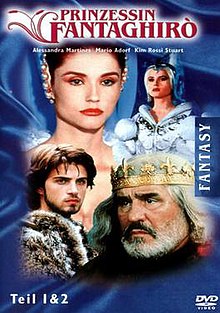Fantaghirò (film)
| Fantaghirò 1 | |
|---|---|
 German DVD cover | |
| Directed by | Lamberto Bava |
| Written by | Francesca Melandri Gianni Romoli |
| Produced by | Lamberto Bava Andrea Piazzesi Roberto Bessi |
| Starring | Alessandra Martines Kim Rossi Stuart Mario Adorf |
| Cinematography | Romano Albani |
| Edited by | Piero Bozza |
| Music by | Amedeo Minghi |
Release date |
|
Running time | 200 minutes (two parts) |
| Country | Italy |
| Language | Italian |
Fantaghirò (aka The Cave of the Golden Rose) is a fantasy television film produced by Reteitalia, directed by Lamberto Bava and starring Alessandra Martines. It originally aired in 1991 as a two-parter, and hence has been known in certain video releases and airings as double-set of Fantaghirò 1 and Fantaghirò 2 (not to be confused with the sequel, Fantaghirò 2). It is the first installment in the Fantaghirò series and is loosely based on the Italian folktale Fanta-Ghiro the Beautiful.
Plot
For many centuries two kingdoms have been at war at each other, though neither side remembers what the war is for. In one of the kingdoms, the warrior king has three daughters: Catherine, Caroline and Fantaghirò. Although Catherine and Caroline are well-behaved princesses, Fantaghirò is outspoken, rebellious, and longs to fight in battle. She constantly argues with her father and two sisters who disapprove of her behaviour.
Fantaghirò secretly learns to fight when she befriends the White Knight, a mysterious warrior whom she meets in the forest. As they are training, she briefly crosses paths with Romualdo, the newly-crowned king ruler of the neighbouring enemy kingdom. Romualdo is enchanted by Fantaghirò's eyes, but is unaware that they belong to the daughter of his sworn enemy.
Romualdo is tired of the war and sends an offer of a single duel to determine the outcome. Fantaghirò's father is told by the magical White Witch that only one of his daughters can win that duel. Seeing no other option, the King commands his three daughters to disguise themselves as male knights so they may fight Romualdo.
Fantaghirò relishes the opportunity and cuts her hair to make her look like a boy, but Catherine and Caroline are fearful. While traveling to Romualdo's kingdom, the three sisters argue about the wisdom of their fighting, and Catherine and Caroline decide that their youngest sister is the most qualified to win. Catherine and Caroline return to their father and Fantaghirò continues on her journey.
Fantaghirò eventually meets with Romualdo, who is confused when he recognises her eyes. After various attempts by Romualdo to discover her true gender by trickery, they eventually battle and Fantaghirò emerges victorious. However, she cannot kill him and returns home in shame. Fantaghirò's father, who is proud of what his daughter has achieved, forgives her. The King also allows Romualdo to continue to rule his people, on the condition that he marry one of the three princesses. Although at first Romualdo is hesitant to agree, when he sees Fantaghirò dressed up as a woman, the two kiss happily.
Cast
- Alessandra Martines as Fantaghirò
- Mario Adorf as King
- Kim Rossi Stuart as Romualdo
- Ángela Molina as the White Witch (White Knight/White Goose)
- Jean-Pierre Cassel as The General
- Stefano Davanzati as Cataldo
- Tomáš Valík as Ivaldo
- Ornella Marcucci as Catherine
- Kateřina Brožová as Caroline
- Stanislava Bartošová as Governess
Production and release

Fantaghirò was inspired by Italian fairy tales collected by Italo Calvino[2] and was shot in locations at Bouzov Castle,[3] Pernštejn Castle,[4] and Lednice in Czechoslovakia.[5] Initially Fantaghirò was to be a single film but the production costs were excessive and so it was decided to make it into a miniseries. The first film has been finished in 1990, but it was then shelved for a whole year; the sequels were approved when it turned out to be a success.[5]
The film was originally aired on Canale 5 on 22 December 1991. Upon its Italian premiere, it was the most watched program of that evening, with over six and a half million viewers (27.50% market share).[1][2] Kim Rossi Stuart's role as Romualdo gained him a national popularity.[1]
Sequel
In the 1992 sequel, the love of Fantaghirò and Romualdo is opposed by the evil Black Witch (Brigitte Nielsen), who steals the prince for herself and plots to eliminate the princess.[2] Both films and the third sequel were later recut (reduced and intersected with each other) into a 200-minute compilation film titled La meravigliosa storia di Fantaghirò ("The Wonderful Story of Fantaghirò") in 1995.[6]
References
- ^ a b c "Torna Fantaghirò: 15 cose da sapere". 21 December 2015.
- ^ a b c "FANTAGHIRO' CONTRO LA STREGA - la Repubblica.it" (in Italian). Ricerca.repubblica.it. 1992-08-28. Retrieved 2014-02-17.
- ^ "Hrad Bouzov". Strednimorava-tourism.cz. Retrieved 2 December 2014.
- ^ "Filmotéka". Hrad-pernstejn.eu. Archived from the original on 28 December 2014. Retrieved 2 December 2014.
- ^ a b Latilla, Antonella (2014-06-20). "Fantaghirò: le 20 curiosità sulla serie tv che non sapevi". Gossipetv.com. Retrieved 2016-08-30.
- ^ "La meravigliosa storia di Fantaghirò". FilmTV. Retrieved 2 December 2014.
External links
- Fantaghirò at IMDb
